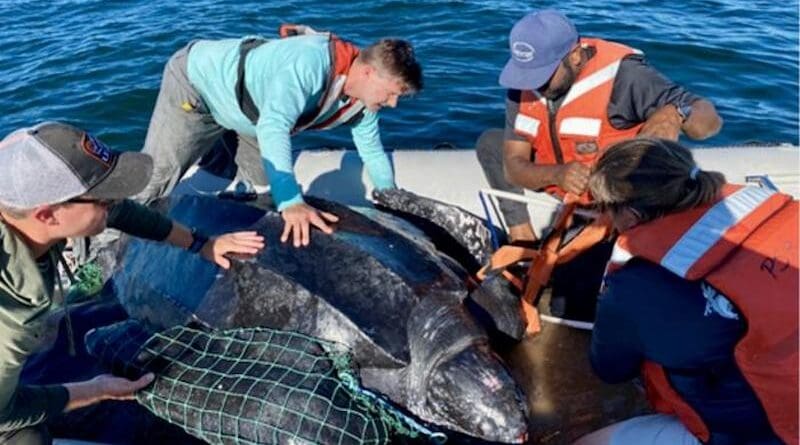Groundbreaking Study Reveals Extensive Leatherback Turtle Activity Along US Coastline
A new study led by a team of marine scientists at the University of Miami Rosenstiel School of Marine, Atmospheric and Earth Science and the National Oceanic and Atmospheric Administration Southeast Fisheries Science Center, provides groundbreaking findings that offer insights on the migration and foraging patterns of leatherback sea turtles along the Northwest Atlantic shelf.
Scientists have known that leatherbacks commonly swim from the South and Mid-Atlantic Bights during the warmer months to reach feeding areas near New England and Nova Scotia, Canada where food is plentiful. They migrate southward again when water temperatures drop during the winter. But questions still remained about where the turtles went in between, and what they were doing along the way.
The study, published in the Journal Frontiers in Marine Science conducted over several years offers unique insights into the utilization of the U.S. coastline by these majestic creatures, challenging previous assumptions and emphasizing key conservation implications.
“Our findings signify a paradigm shift in understanding leatherback turtle behavior along the U.S. coastline,” said Mitchell Rider, a research scientist at the Rosenstiel School’s NOAA Cooperative Institute for Marine and Atmospheric Studies and a lead author of the study. “By highlighting key foraging grounds and migration patterns, we aim to inform targeted conservation strategies to safeguard the future of these magnificent creatures.”
Where the Leatherbacks roam
The research involved the tagging and monitoring leatherback sea turtles (Dermochelys coriacea) off the coasts of Cape Cod, Massachusetts and Beaufort, North Carolina. Between 2017 through 2022 the team successfully tracked 52 leatherback sea turtles, using advanced satellite tags capable of recording location, depth, and temperature data. Applying the tags involves finding and capturing the leatherback turtles, which can weigh several hundred pounds—a challenging task. The scientists were able to track and learn where the turtles go and the behaviors they exhibit during their migrations.
The waters off Cape Cod and Nantucket promote a high abundance of jellyfish in the late summer and early fall, which the leatherbacks appear to be taking advantage of. The scientists observed some of the leatherbacks tagged along Nantucket Shoals, stayed in the area for weeks to months after tagging before migrating back south.
In the Mid-Atlantic Bight, the team inferred that there is food availability, given the high number of leatherbacks that displayed feeding-like behavior year after year. However, the team noted the lack of research on prey distributions in this area, and further observations for leatherbacks would benefit by returning to the site to deploy camera tags to determine what the leatherbacks are feeding on.
The South Atlantic Bight appears to support several stages of the migration cycle: nesting, post-nesting foraging, and overwintering. Not as many leatherbacks frequented this area, but the ones that were tracked displayed feeding-like behavior especially along the continental shelf ridge. Previous research in the area indicates that blooms of cannonball jellyfish occur nearshore in the South Atlantic Bight primarily during the spring, which coincides with leatherbacks overwintering and nesting stages of their migration cycle.
“Our study revealed a significantly higher utilization of the U.S. coastline by leatherbacks, particularly along regions of the Mid-Atlantic Bight, South Atlantic Bight, and Southern New England. These areas emerged as possible major foraging grounds for leatherbacks migrating along the United States coastline, with notable activity observed off the coast of North Carolina.
“A key finding was further defining the Mid-Atlantic Bight as a critical foraging ground for leatherbacks from past studies, identified through sophisticated behavioral analysis,” said Rider. “By incorporating diving metrics such as dive frequency and duration, the study provides a comprehensive understanding of leatherback behaviors that distinguishes between their migration and foraging activities.”
Furthermore, the study highlighted the vulnerability of leatherbacks to incidental capture by fisheries and vessel strikes, underscoring the urgent need for conservation efforts to mitigate these risks. With impending developments, particularly the construction of offshore wind farms in the Mid-Atlantic Bight and Southern New England regions, the findings serve as a relevant guide for conservation managers to minimize impacts on this endangered species.

